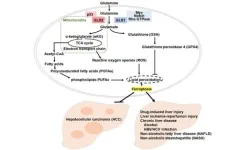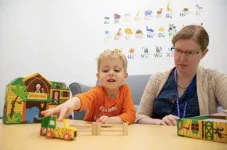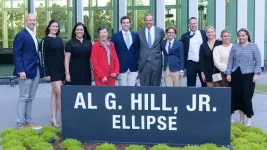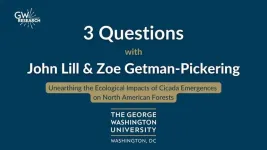(Press-News.org) HOUSTON ― A team of researchers at The University of Texas MD Anderson Cancer Center has developed a new method for using extracellular vesicles to enhance responses to immunotherapy in glioblastoma, potentially opening the door for wider use of engineered messenger RNA (mRNA) for cancer therapy. The study was published today in Nature Communications.
Earlier this year, a team of researchers led by Betty Kim, M.D., Ph.D., and Wen Jiang, M.D., Ph.D.,developed a novel method for loading mRNA into extracellular vesicles, small structures created by cells to transport biomolecules and nucleic acids within the body. The current study builds on that research by demonstrating the anti-tumor potential of mRNA-loaded extracellular vesicles.
mRNA therapies, which were recognized by the 2023 Nobel Prize in Physiology or Medicine, have long held breakthrough potential in pathogenic infections as well as diseases like cancer. However, challenges remain to accurately deliver mRNA throughout the body. For years, scientists have studied potential delivery mechanisms, including lipid or polymeric nanoparticles, but each of these has its own limitations.
“There are two primary challenges in using mRNA therapies for cancer treatment. First, how do you accurately target the tumor cells in the body? Second, how do you produce enough of the therapy for human use?” Jiang said. “Our approach solves those two problems.”
The quantity problem is solved by using a high-throughput system to produce mRNA-loaded extracellular vesicles from engineered cells. Host cells and a designer plasmid encoding the mRNA are subjected to two extremely short electric pulses, causing membranes inside the cell, as well as the cell membrane itself, to become temporarily permeable. This leads the cells to secrete many extracellular vesicles loaded with mRNA material that can then be collected.
For this study, the researchers engineered the extracellular vesicles to express the CD64 protein on their surface, which serves as a docking mechanism to load both anti-CD71 and anti-PD-L1 antibodies. Once in the body, they seek out CD71 and PD-L1, both of which are commonly overexpressed in glioblastomas.
These extracellular vesicles were loaded with mRNA encoding interferon-gamma, an immune signaling protein. When the vesicles bind to receptors on tumor cells, they are internalized and release the mRNA.
One reason glioblastoma is difficult to treat is that the downregulation of MHC-1, as well as other features of the tumor microenvironment, create an immunosuppressive environment that evades detection and limits the effectiveness of immunotherapies. The mRNA reverses that, changing the tumor microenvironment to make the tumor detectable to the immune system and more responsive to immunotherapies. In the preclinical models, a significant increase in survival time and initial antitumor activity was observed within 7 days of injection.
“We chose glioblastoma because it has limited treatment options currently,” Jiang said. “We know that interferon-gamma can induce responses to immunotherapy in glioblastoma, but delivering it to the tumor cells has thus far proven to be a major challenge due to its half-life and the inability for most delivery systems to cross the blood-brain barrier. These results hopefully pave the way for mRNA-loaded extracellular vesicles to be used in cancer applications.”
According to Jiang, one of the other advantages of this approach is that it’s plug-and-play, meaning it can be adapted to other tumors by simply changing the antibodies to target those overexpressed in other tumor types.
Further preclinical work is ongoing to continue to improve production methods and profile the safety of extracellular vesicles before they are applied in clinical settings.
This work was supported by the National Cancer Institute (P30-CA016672) and the National Science Foundation (OIA-1946231). A full list of co-authors and disclosures can be found here.
END
mRNA delivered by extracellular vesicles induces immunotherapy response in glioblastoma
Preclinical study suggests method could be adapted to other hard-to-treat tumor types
2023-10-19
ELSE PRESS RELEASES FROM THIS DATE:
Point-of-care technology initiative awarded $8.9 million renewal
2023-10-19
UMass Chan and UMass Lowell’s point-of-care technology initiative awarded $8.9 million renewal
UMass Chan Medical School and UMass Lowell have received an $8.9 million award from the National Institutes of Health (NIH) for renewed support of their initiative to advance the development of home-based and point-of-care health technologies. The program aims to jumpstart new tools to address heart, lung, blood and sleep disorders, especially in underserved populations.
The Center for Advancing Point of Care Technologies ...
GLS2 shapes ferroptosis in hepatocellular carcinoma
2023-10-19
“[...] we hope that our findings will inform future decisions regarding treatment of liver disease.”
BUFFALO, NY- October 19, 2023 – A new editorial paper was published in Oncotarget's Volume 14 on October 19, 2023, entitled, “GLS2 shapes ferroptosis in hepatocellular carcinoma.”
In their new editorial, researchers Sawako Suzuki, Divya Venkatesh, Tomoaki Tanaka, and Carol Prives from Columbia University discuss ferroptosis regulation of GLS2 as a potential therapeutic strategy against liver diseases.
“More than a decade has passed since our group (1) as well as ...
Groundbreaking study on bilingual children with Developmental Language Disorder
2023-10-19
Amanda Owen Van Horne sits on the floor while a child mixes up cake batter in a play kitchen.
While at play, an intensive language therapy program is also underway for preschool-aged children with developmental language disorder (DLD) at the University of Delaware’s Treatment Efficacy and Learning Language (TELL) Lab. The child says, “Him cooking.” Owen Van Horne repeats back, “He is cooking.”
DLD is a problem with learning and using language not attributed to a hearing impairment or intellectual disability, according to DLD ...
The Trinity Family Foundation grants major gift to Center for BrainHealth to honor the memory of Al G. Hill, Jr.
2023-10-19
The Trinity Family Foundation has pledged a generous $4 million gift to the Center for BrainHealth to advance the science of brain health, in memory of Al G. Hill, Jr., a renowned Dallas entrepreneur and philanthropist.
The thoughtful investment will support burgeoning research at the Center for BrainHealth, focused on deepening our understanding of neuroplasticity – the brain’s lifelong ability to change, adapt, get stronger and work better.
In recognition and gratitude, the center’s ...
Research shows new documentation tool could help optimize seizure treatments in patients with epilepsy
2023-10-19
New research from the University of Colorado Anschutz Medical Campus studies a new tool that will help medical providers identify patients who are failing epilepsy treatments earlier in order to change treatment to rapidly optimize positive outcomes.
The study was published online today in Neurology® Clinical Practice, an official journal of the American Academy of Neurology.
The study was a quality improvement project that tested the implementation of an easy-to-use standardized electronic health record documentation tool, which dramatically improved the accuracy and completeness of important clinical documentation ...
Neuroscientists to reveal new insights into Alzheimer’s
2023-10-19
Dementia experts from UC San Francisco will join their peers from around the globe at the annual Clinical Trials on Alzheimer’s Disease (CTAD) conference in Boston from Oct. 24 to 27.
Presentations cover breakthroughs in therapies that clear amyloid – a hallmark of Alzheimer’s – and a symposium on patients with early Alzheimer’s symptoms who were treated with the anti-amyloid medication donanemab, which may be approved by the end of the year. Other topics include novel treatments, diagnostic blood biomarkers, amyloid-related imaging abnormalities (ARIA) and Medicare coverage.
This year’s ...
New study finds racial and ethnic disparities persist in access to chiropractic care and physical rehabilitation for adults with low back pain
2023-10-19
BOSTON - Low back pain is the leading cause of disability worldwide and a major driver of healthcare costs in the United States, according to the World Health Organization. Over the last 20 years, recommended treatment of low back pain has shifted from use of pain medications including opioids to early use of nonpharmacologic treatments such as spinal manipulation and therapeutic exercise which are commonly provided by chiropractors and physical therapists. However, while nearly all Americans will experience back pain at some point in their lives, most Americans ...
Record-breaking fast radio burst offers path to weigh the Universe
2023-10-19
In a paper published today in Science, a global team led by Macquarie University’s Dr Stuart Ryder and Swinburne University of Technology’s Associate Professor Ryan Shannon, report on their discovery of the most ancient and distant fast radio burst located to date, about eight billion years old.
The discovery smashes the team’s previous record by 50 per cent. It confirms that fast radio bursts (FRBs) can be used to measure the “missing” matter between galaxies.
The source of the burst was shown to be a group of two or three galaxies that are ...
Unearthing the ecological impacts of cicada emergences on North American forests
2023-10-19
WASHINGTON (October 19, 2023) – Every 13 or 17 years, billions of cicadas emerge from the ground to reproduce in eastern North American deciduous forests. One of the largest emergence events of these insects happened in 2021 when theBrood X cicadas emerged. Researchers who studied that once-in-a-generation event are now unveiling the impact this occurrence had on forest ecosystems, specifically on birds, caterpillars and trees.
In a new study published today in Science, researchers at the George Washington University, Georgetown University and the University of Maryland quantified the widespread ...
Agricultural landscapes and heat erode nest successes of birds across the United States
2023-10-19
Maximum temperature extremes reduce the nesting success of birds across the United States by nearly 50% in agricultural landscapes but not forests, according to a new study based on more than 20 years of citizen-science nest-monitoring data. The findings show that future warming may exacerbate the negative effects of habitat conversion on bird fitness, especially among species of conservation concern in human-dominated landscapes. Habitat conversion and climate change are fundamental drivers of biodiversity loss worldwide. However, ...
LAST 30 PRESS RELEASES:
UC Riverside scientists win 2025 Buchalter Cosmology Prize
SETI Institute opens call for nominations for the 2026 Tarter Award
Novel theranostic model shows curative potential for gastric and pancreatic tumors
How beige fat keeps blood pressure in check
Fossils reveal ‘latitudinal traps’ that increased extinction risk for marine species
Review: The opportunities and risks of AI in mental health research and care
New map reveals features of Antarctic’s ice-covered landscape
Beige fat promotes healthy vascular function and blood pressure in mice
Chronic low-dose pesticide exposure reduces the life span of wild lake fish, China-based study shows
Tiny earthquakes reveal hidden faults under Northern California
Long-term pesticide exposure accelerates aging and shortens lifespan in fish
Professor Tae-Woo Lee's research group develops groundbreaking perovskite display technology demonstrating the highest efficiency and industry-level operational lifetime
The “broker” family helps tidy up the cell
Ecology: Mummified cheetahs discovery gives hope for species’ Arabic reintroduction
Researchers survey the ADHD coaching boom
Air pollution and cardiac remodeling and function in patients with breast cancer
Risk of suicide in patients with traumatic injuries
Post–intensive care syndrome
The lifesaving potential of opioid abatement funds
The Frontiers of Knowledge Award goes to Allan MacDonald and Pablo Jarillo-Herrero for their discovery of the “magic angle” enabling science to transform and control the behavior of new materials
Discovery reveals how keto diet can prevent seizures when drugs fail
JMIR Publications and Sikt announce pilot flat-fee unlimited open access partnership
Finding new cell markers to track the most aggressive breast cancer in blood
A new, cleaner way to make this common fertilizer
Fire-safe all-solid-state batteries move closer to commercialization
Disinfecting drinking water produces potentially toxic byproducts — new AI model is helping to identify them
Unplanned cesarean deliveries linked to higher risk of acute psychological stress after childbirth
Healthy aging 2026: fresh pork in plant-forward diets supported strength and brain-health biomarkers in older adults
Scientists identify pre-cancerous states in seemingly normal aging tissues
Itaconate modifications: mechanisms and applications
[Press-News.org] mRNA delivered by extracellular vesicles induces immunotherapy response in glioblastomaPreclinical study suggests method could be adapted to other hard-to-treat tumor types






